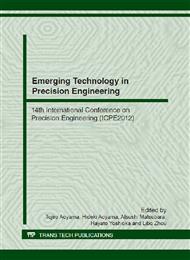p.587
p.592
p.598
p.604
p.610
p.615
p.621
p.627
p.633
Fundamental Study on Nanoremoval Processing Method for Microplastic Structures Using Photocatalyzed Oxidation
Abstract:
Micro plastic structures, typified by photoresists for semiconductor devices or various MEMS devices, photosensitive resins of microstereolithography, and so on, play one of the most important roles in the microdevices manufacturing. In order to process finer plastic structures with higher reliability for more complexly-modulated microdevices in the next generation micromanufacturing field, a nano removal processing method, which can be applied to a corrective machining process with the removal resolution less than 10nm in both lateral and vertical direction, is strongly required. In this study, we propose a novel nano removal processing method for micro plastic structures with photocatalyzed oxidation. Here, we apply photocatalysts micro particles as a specially designed material removal tool tip. Since a light energy is not directly used for processing the material, a material removal resolution does not depend on the diffraction limit. Further, using photocatalysts is free from micro tool wear problem. As the first report, in order to verify the fundamental feasibility of the proposed method, we performed basic experiments using TiO2 micro particles with the diameter of 500nm for cured photosensitive resin surface. An AFM observation of the processed surface showed that a vertical removal resolution of 8nm was achieved.
Info:
Periodical:
Pages:
610-614
Citation:
Online since:
November 2012
Authors:
Keywords:
Price:
Сopyright:
© 2012 Trans Tech Publications Ltd. All Rights Reserved
Share:
Citation:


